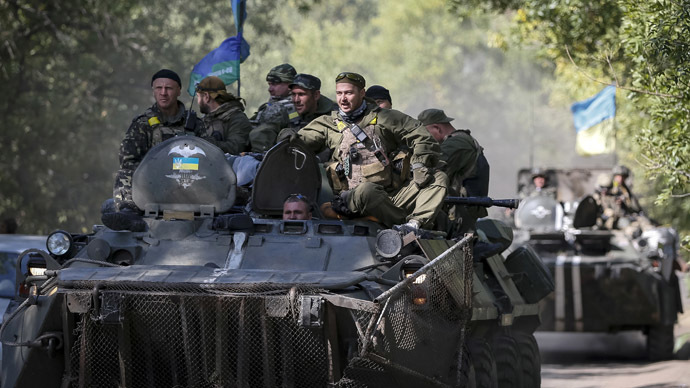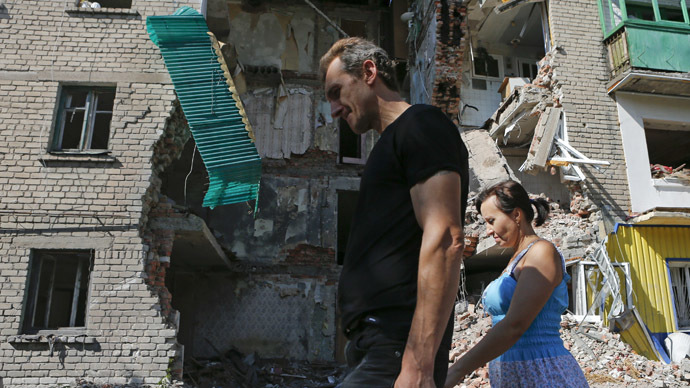Peace talks on Ukraine’s crisis have started in Minsk, Belarus, with the Kiev authorities, E. Ukraine self-defense forces, Russia and the OSCE. All sides hope ceasefire negotiations will succeed.
Three leaders from the self-defense forces have arrived for truce talks. Among them are Aleksandr Zakharchenko, Prime Minister of Donetsk People’s Republic, Igor Plotnitsky, PM of Lugansk People’s Republic, Aleksey Karyakin, the head of LPR’s parliament and Andrey Purgin, Deputy PM of DPR.
“[We] expect that the key issues which may be discussed at the negotiations in Minsk and can be agreed on by the participants of the talks will be exchange of prisoners ‘all for all’, monitoring of the situation under the authority of the OSCE, withdrawal of Kiev troops from the residential areas of Donetsk and Lugansk Republics and, finally, a ceasefire,” said Miroslav Rudenko, one of the Donbass self-defense leaders told Interfax.
According to Rudenko, the participants of the meeting will agree on a peaceful settlement of the crisis, which involves a ceasefire and exchange of prisoners.
Still no #ceasefire announcement, almost 1,5 hours after it was expected #Ukraine#Belarussiatalks
— PaulaSlier_RT (@PaulaSlier_RT) September 5, 2014
Leonid Kuchma, ex-Ukraine president, is representing the Kiev government.
According to Kuchma, who served from 1994-2005, the Kiev authorities came to Minsk “for peace, to stop the military actions” in the crisis-torn country. He added that Kiev is ready for a ceasefire.
“If the other sides are ready [for a ceasefire], too, then out plan should be signed,” he said, “We need to stop killing each other.”
The Russian side is represented by Mikhail Zurabov, Russia’s Ambassador to Ukraine.
Zurabov is optimistic that a series of documents will be signed during the meeting in the Belarusian capital.
“I think they will [be signed],” he told the journalists ahead of the talks.
In the meantime, the Organization for Security and Cooperation in Europe, whose representatives are also taking part in the peace talks, is preparing the ceasefire proposals in eastern Ukraine, according to Russian OSCE representative Andrey Kelin.
“The Swiss presidency said that OSCE secretariat …is preparing its proposals so that to the moment of the ceasefire, OSCE mission in Ukraine may perform these functions [controlling the ceasefire],” Kelin told Interfax.
He added that control could be performed both directly and with the help of drones.
“We have two aspects. The first is to control with the help of the observers which will patrol [the areas]… The second is to use drones, a possible that is currently being discussed by the OSCE,” he said.

Kiev & self-defense forces ready for Friday ceasefire if Minsk talks successful
Earlier Ukrainian President Petro Poroshenko expressed “great hope” that the peace process in Ukraine will commence in Minsk.
"At 14:00 local time [11:00GMT Friday], provided the [Minsk] meeting takes place, I will call on the General Staff to set up a bilateral ceasefire and we hope that the implementation of the peace plan will begin tomorrow," Petro Poroshenko said on the sidelines of a NATO summit in Wales on Thursday.
The self-proclaimed People's Republics of Donetsk and Lugansk came up with their own proposals. They included a temporary ceasefire, a demilitarized zone, flight bans for Kiev and OSCE monitoring.
The self-proclaimed People's Republics of Donetsk and Lugansk are “ready to order a ceasefire tomorrow on September 5, 2014 at 14:00 local time [11:00GMT] if agreement is reached and the Ukrainian representatives sign up to the plan for a political settlement of the conflict,” the leaders of the two republics said in a joint statement.
The announcements pave the way for implementing the seven-step peace plan which was proposed to the conflicting sides by Russian President Vladimir Putin on Wednesday.
The Russian president’s proposals envisage: a the halt to the militia’s advances in the Donetsk and Lugansk Regions; withdrawal of Kiev troops to a distance that makes shelling impossible; objective international control over the ceasefire; a ban on the use of combat aircraft against civilians; unconditional prisoner exchange; organization of humanitarian corridors, and provision of direct access for repair crews to destroyed infrastructure.

